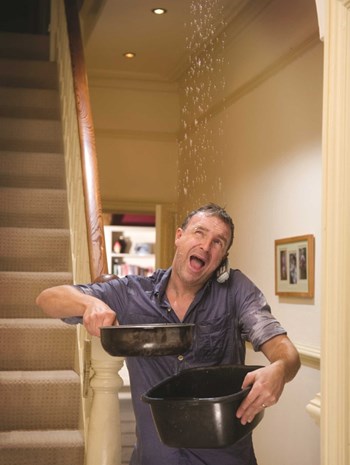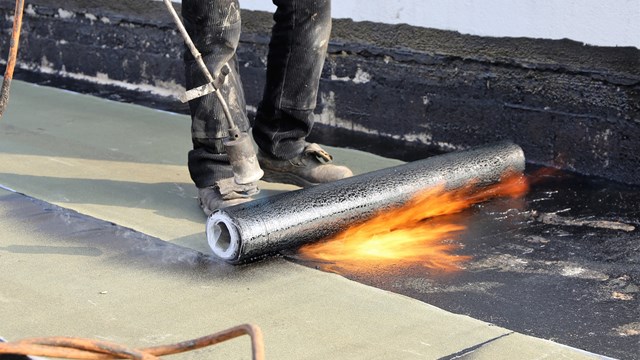
As we city dwellers go about our busy lives, we often forget about the plain facts of life here on this spinning globe: gravity creates an unceasing tension in the materials we assemble into buildings and other structures. Whether or not we are paying attention, all of matter is reacting to gravity’s pull, and those forces can result in small tears or holes in facades, roofs and other parts of a building—a fact that’s never too far from Wayne Bellet’s mind.
“Nobody wants to appreciate that the earth is moving. And when you have a plane change on a roof, that causes stress on the spot where the two planes meet,” says Bellet, owner of Manhattan-based Bellet Construction.
Over time, such stresses can result in a hole in a roof, oftentimes where planes intersect, such as where flashing surrounds a chimney. Even if it’s just a pinhole leak to start, if it is left undetected for very long, that dripping water can cause serious damage to a building and even adversely affect its structural integrity.
Water leaks are the bane of many apartment owners and many building superintendents. But unlike a drippy faucet or a drafty window, which often can be simply fixed, water leaks sometimes can be very difficult to find and remedy. Many different technologies exist to help find the source and the extent of leaks and other technologies can help minimize the damage these leaks cause. Knowing what makes leaks happen, the ways that they are found, and how they’re repaired is essential for anyone living in a multi-family building. Because after all, such a leak might happen in nearly anyone’s apartment and still affect everyone in the building because of a costly fix that all will have to pay for.
Spotting Problems
A longstanding leak might signal the need for a major building improvement project, but it might also require a less invasive solution, such as a spot replacement of just part of a roof. Knowing what solution to use is the contractor’s bailiwick, but understanding something about the fixes for water leaks, and the best practices for finding the source of the leaks, is the responsibility of each building resident.
Water leaks in a building are generally of two kinds: rain-related or plumbing-related. “Are you dealing with a leaky building or a leaky pipe,” says Jack Kleinfeld, owner of Bronx-based Kleinfeld Technical Services, which uses various methods for detecting leaks, including infrared imaging.
A leak doesn’t always have to be particularly severe before residents notice water stains or seepage in the walls or ceiling, and some leaks will show up more or less immediately. Other leaks could be happening for weeks before anyone notices. Some leaks might not be evident in any way, such as a pipe leak for which the building’s management can’t find the source. Such a leak might initially be detected through the water meter on a building’s heating system.
One common water-related issue in multifamily buildings in the city is leaking pipes that are connected to steam boilers. In these systems, condensate return lines are buried in the floor and can develop leaks. Such a leak is first detected through the boiler’s water meter indicating that the system is losing water. At that point, a building’s management team should have experts bring in monitoring equipment to find the leak.
These days, infrared or “thermal” imaging often is used to find a leak’s source. Since a leak in a multifamily building can come from different spots on a large surface such as the building’s exterior, thermal imaging covers all of that territory by looking for a temperature signature on the surface that indicates where the leak is located. The technology helps a professional to find areas of the building that are water-damaged. When used on a roof, a thermal imaging device scans the surface horizontally, detecting where moisture is trapped within the roof.
“From that information you can decide how to fix it, or where to remove the wet section of roof. An infrared roof scan is simple, effective, inexpensive and quickly done, compared to the cost of roofers. There’s also no noise or destruction,” Bellet says.
Another fairly routine way of inspecting a building to find water leaks is doing a roof survey. In a roof survey, the building’s management will call in a professional, who will do a thermal imaging survey of the entire roof. He will also take photos of the roof and then mark with paint any damaged area of the roof. Generally, a professional will offer spot fixes of the roof when small parts of it are damaged or leaking.
“If a large portion, such as 50 percent or more of the roof is compromised, you’re probably better off doing a roof replacement,” Kleinfeld says, cautioning against temporary fixes that could do more harm in the long run. “You really shouldn’t re-roof over a wet area.”
The single most effective preventative step to take to avoid roof leaks is proper gutter and downspout maintenance. Make sure these parts of the building are always clear and free of obstructions, by regularly cleaning them.
One method of detecting leaks in a roof sort of imitates what happens when a gutter or downspout is clogged—it backs up water onto one part of the roof. By creating a dam made of sheet metal around an area of a flat roof surface and then applying water to that area where the leak was, specialists can trace a leak to see where the water is coming into the building.
Some companies, like American Leak Detection, stick strictly to the inspection side of this business. The company finds water leaks noninvasively—without excavation or demolition. For exterior water penetration issues, American Leak Detection uses thermal imaging technology and also electric vector mapping, which employs an electric current and water to find even a pinhole-sized tear.
Whether or not an apartment owner hears a drip coming from the roof or elsewhere, such a leak might be making a sound that still is detectable. Specialists sometimes use ultrasound technology to hear and find an active leak of water or steam. This technology isn’t used on roofs, for obvious reasons—it’s too loud outside for the technology to work.
Repairing Leaks
The most common source of water leaks in suburban and urban multifamily buildings is the roof. Areas of the roof where flashing is used typically are the weakest points on the roof surface, and are the spots most likely to develop a leak. Because each leak is unique, there’s no rule of thumb for how long it can take to find a water leak. Finding the source of the problem might take just a couple of hours, or it might require many hours of work, depending upon the size of the property.
Costs for bringing in a leak detection specialist vary. Several different types of professionals are qualified to do the job, including firms that refer to themselves as leak detection specialists, as well as engineers or contractors with expertise in the area. Hiring such professionals can start at $600 per man per day, and often two men are needed to inspect for a leak problem. Some day rates range upwards of $2,000.
Knowing how to pick the right company to handle the job is a matter of matching up skills and needs. For example, if the leak is isolated to just several apartments, a company such as American Leak Detection could find the source of the problem.
“Sometimes people call us because they know they have to replace the roof, and they hire us to see what spots need to be replaced,” says Travis Huang, New York City field manager for American Leak Detection.
For a whole building leak problem, management always should consult the building’s engineer regarding how to proceed. If they pay attention, though, building owners and management will be able to pick out the best firms to do the work, based in part upon what they say. “Someone with the experience and training in finding leaks—who is willing to ask questions and listen to answers—is really what you want,” Kleinfeld says.
Sometimes, replacement of an entire building system could be the best solution to a problem with leaks, says Kevin Crawford, a senior estimator for West New York Restoration, a building envelope restoration company. “Once you’re chasing leaks, it indicates the age of the system. The roof might need to be replaced, or the windows or façade might need to be replaced,” he says.
When they are found, leaks are repaired in various ways. If the leak is in the area of flashing around a chimney, for example, the flashing might need to be replaced and repainted. The type of fix for a leak always is dependent upon the type of problem, but conditions of the building material that is affected, the age of the building component (such as a roof, stone façade, or even steel window lintils), and the size and scope of the leak all factor into a remedy. The amount of damage caused by the leak also is part of the equation.
Determining whether the fix of the roof leak worked can be done with another low-tech water test. The expert simply floods the area of the roof that’s been repaired to see if it leaks. This is one of the parts of his job that Bellet relishes. “I love a bad leak. I am so sure I can fix your leak, I won’t charge you if I don’t fix it,” he says.
Sometimes the leak is in the middle of the basement floor of a building. What’s happening in such a case is that the water table underneath the building is rising and falling because of rains that soak the soil and seep up into the basement.
To fix this type of problem, a contractor will install a water-tight membrane on the basement floor and up the basement walls at least eight inches and as high as a few feet. The same method can be used to seal an elevator pit, which is essential to safeguard all in the building.
“You can’t have water in an elevator pit—you have [electrical] cables in there,” Bellet says.
Other basement leak fixes could be much more invasive. Some buildings have basement water problems because their exterior brick walls are porous due to moisture coming through them. In these scenarios, the water is coming through because the brick is in contact with a water source leaching from the soil. So, a contractor must excavate to the base of the building to get to the root of the problem. This fix involves moving soil and landscaping, and the logistics can get pretty complicated.
Not every contractor will give an ironclad guarantee on his work, but many are passionate about their jobs, and dedicated to helping their clients. These are the specialists that a building’s management should be working to find, because they will do the job right.
“I always get the leak. And if I don’t, I don’t rest until I do,” Bellet says. “It drives my wife nuts.”
Jonathan Barnes is a freelance writer and a regular contributor to The Cooperator.









Leave a Comment